ALLIGATOR
BEHAVIOR page 5k: BABY
ALLIGATORS --page
11 Alligator nests and babies page 1 2 3 4 5 6 7 8 9 10 12
This
page
was born 09/15/2023. Rickubis designed
it. Last
update: 02/21/2024
Images
and
contents on this page copyright ©2023-2024 Richard M. Dashnau
Most of these were
posted on the RICKUBISCAM
page first, then moved here. Unlike most of my other pages,
the entries on this page
will be shown in chronological order from top to bottom
(since this makes following the progression of events easier), so
scroll to the
bottom
to see the latest posts. This may require a lot of scrolling,
depending
on how often I've recorded events--but I hope that you'll
enjoy the journey.
06/11/2023 Brazos Bend
State
Park. Around 9am, I could see two alligator nests on the Spillway
Trail. The first one I saw was described to me last
week,
by
some visitors who said they saw an alligator working on it! When I
got
there, there was no gator, and the nest looked incomplete...or
plundered. But today, the nest looked
intact. Even more interesting--two
alligators were near it! The first image is a panorama shot
that
shows how close that nest was to the Spillway Bridge. It's about 50
steps from
the East end of the bridge.



When
I
returned about 30 minutes later, I couldn't see the alligators. But
I
was sure curious about the pair of gators watching the nest. I had
to
get back to the Nature Center
to lead a hike, so I didn't look further.


On
08/06/2023, at Brazos Bend
State
Park I climbed the 40 Acre Lake Observation Tower to get a few
images
to show the
condition
of 40-Acre Lake and Pilant Lake. Pilant Lake looks better than it
did
this time last year, while 40-Acre Lake also looks better than
last year--but not by much. The first picture shows the barrier that
marks the closed part of 40-Acre Lake Trail. The nest is
not
visible in the wide
shot, but it was just around the bend.
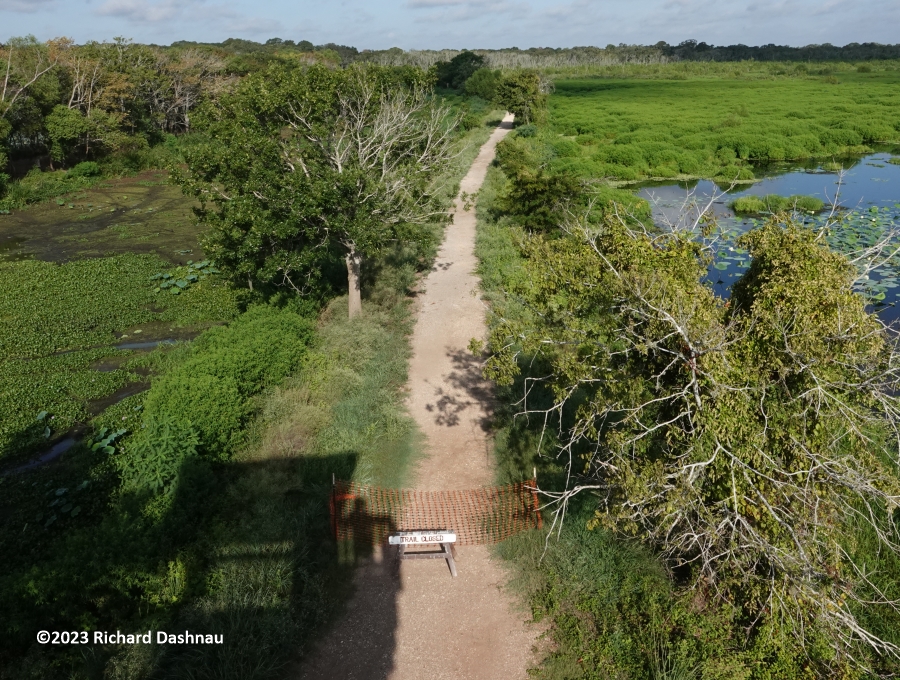

The
alligator nest about 50 yards East of the Spillway Bridge was still
there, and I found the mother gator in the water near it.



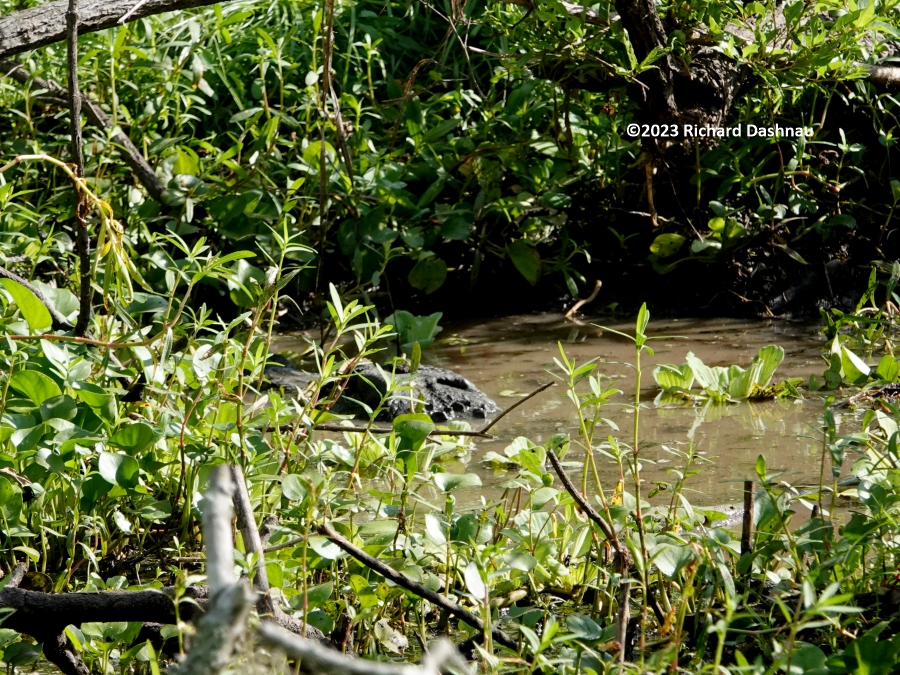
I
saw the second nest about 10 minutes later. It was just a bit East
of
bird box #18 (to the right as you look at the nest). This
nest
also had an alligator near it, directly in front.
It was not
visible when I returned a little later. Water levels near
Pilant
Lake look ok now, but it will take about 60 days for eggs in
those nests to hatch. I hope the water is still
there by the end of August--when the eggs usually hatch.


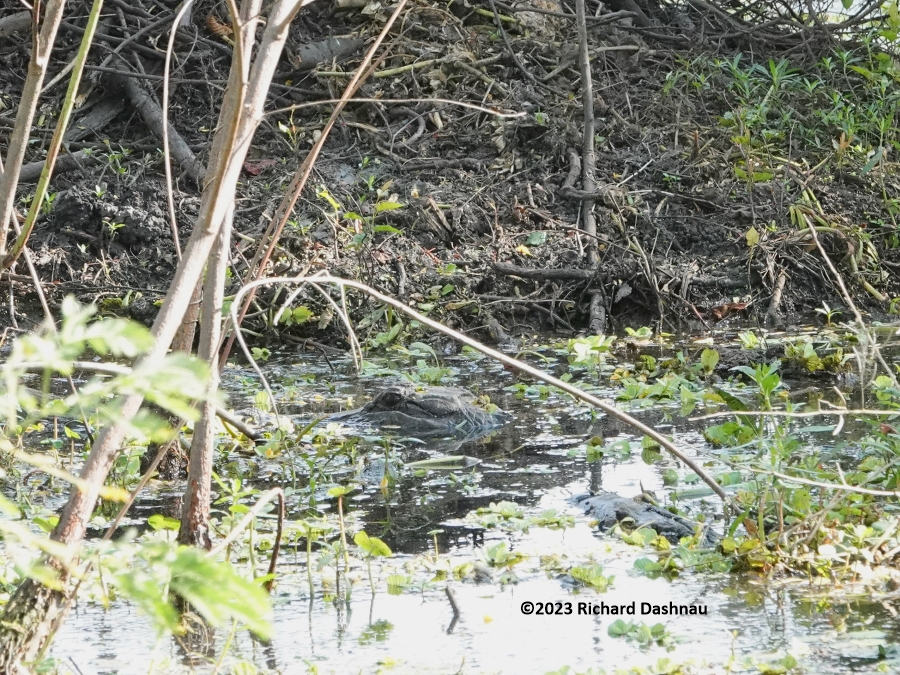
Brazos
Bend State
Park 08/20/2023.
I spent 90 minutes with some visitors watching some gator drama near
the 40 Acre Lake Observation Tower
(details
to come later). A few visitors that had walked down the Spillway
Trail
from Elm Lake mentioned that they'd seen baby alligators along the
way.
I tried to figure
out where they'd seen them-since I knew
about 2 nests there. They all said the the babies seemed to be much
further East than the nests were. One family said that
they'd
seen an alligator cross from the South side of the trail then get
chased back across by the mom gator that was there. One group said
that
another Volunteer
had shown them the babies.
When I went to
find the babies, I inspected the nests, and it seemed that both had
been excavated. But I couldn't hear or see any babies. I walked past
both nests, past
bird box 24, and when I didn't find them, I
turned and walked West. The images below show the nest just East of
the
Spillway Bridge July 23, 30 and today, August 20.



The
images
below show the nest just East of the Bird box #18 July 23,
30 August 13, and today, August 20. Both sets of
images
show how nests have changed.



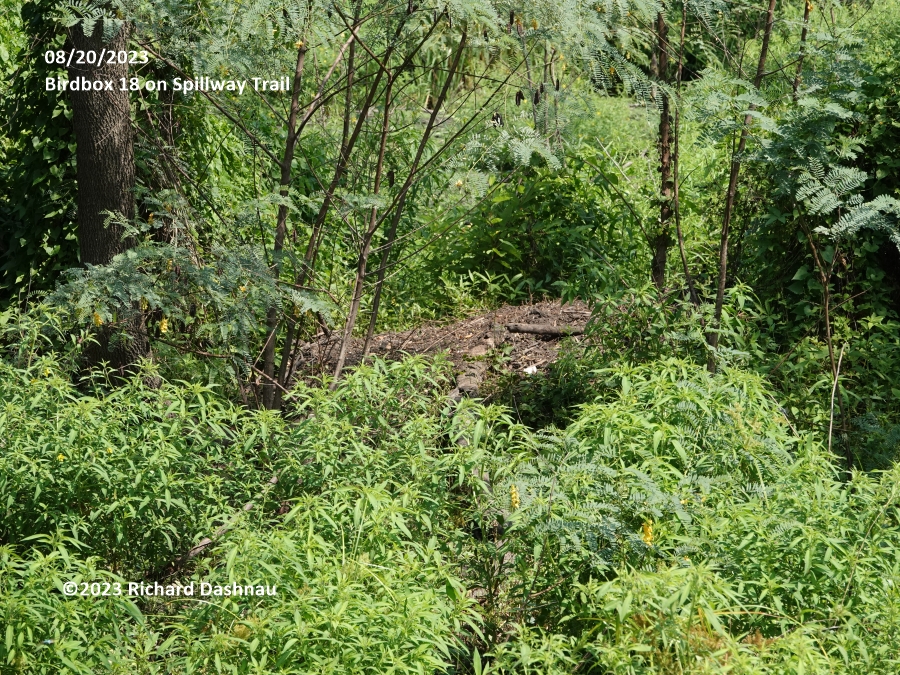
A
family of visitors came by, and we talked about the baby gators. I
still didn't find them, and the family continued to the tower. I had
turned East again, and was walking
very slowly when that same
family came back. I'd hoped to show them the babies. The family
passed
me, and then called out to me. When I looked up, an small alligator
(about
4 feet long) was at the South edge of the trail about 75 yards
East. I hurried to catch up to the family, and we walked a
little
closer to the alligator. I kept us back a bit
so we would be
able to see the alligator cross. When it crossed into the plants on
the
North side, I suggested we pause, and I told them what I'd heard
about
the mom
gator being in the water somewhere in the area. I'd
just finished telling them that story when there was commotion in
the
vegetation and the small gator reappeared, then
hurried back across the
trail. It rested for a few minutes, then went back into
Pilant Slough.


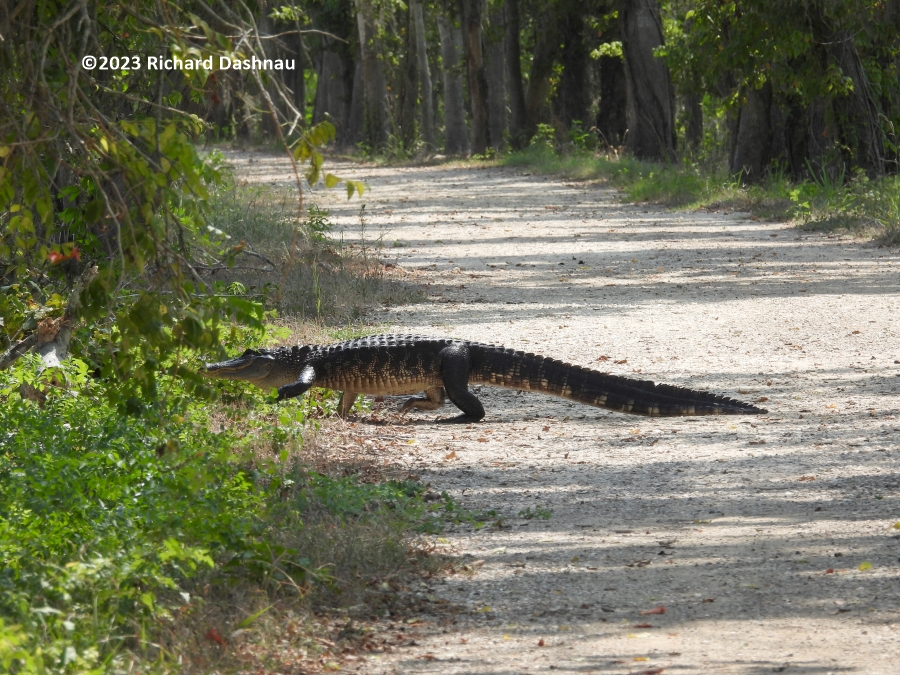
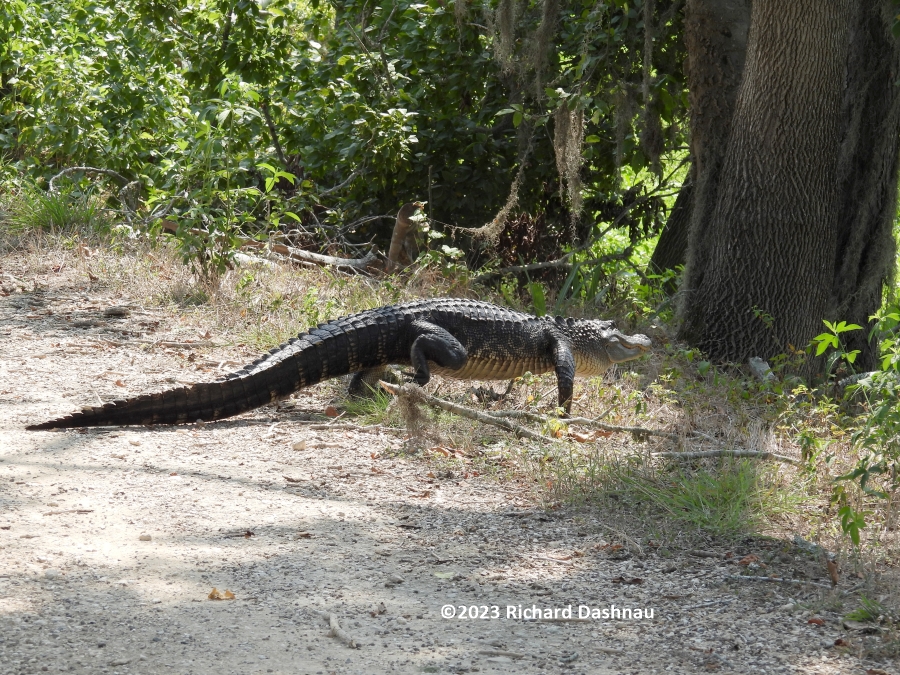
We
walked very slowly towards the area the gator had come out of...and
I
found mom gator down in the water. We moved closer (but still
up
on the trail) until we got to a
place that allowed a clear
view of the water. The baby gators were there, and mom gator's head
was
also visible. All was calm--the babies weren't stressed, and mom
gator
was
also relaxed--so we could talk a bit. I took a few pictures, then
headed back so I could be at the Nature Center by noon.




At
Brazos Bend State
Park 08/27/2023, 09/03/2023,
09/10/2023. I was able
to
find a pod of baby alligators along the Spillway Trail. I can't say
for
sure that I'd found the same
pod each time, although it's possible that I did. During that time,
I
could see the water level in that area was lower each week.
(details
to come later). So
the following images show the baby alligators (and sometimes their
mother) as I found them. I shot some very short video clips that I
may
add
later.
Note that the closeup images of the gators are telephoto shots,
taken
from at least 15 yards away. The wide shots (showing the general
area)
show how far away I
was.
On 08/27/2023,
the pod was under this fallen tree that was near Bird Box #18. This
was
about 70 yards West from where I'd found a pod the week before, but
only about 20
yards in front of where one of the alligator nests had
been this summer. I could not find a large alligator nearby
that
might have been their mother. But she could have
been submerged right there, of hidden by plant cover.



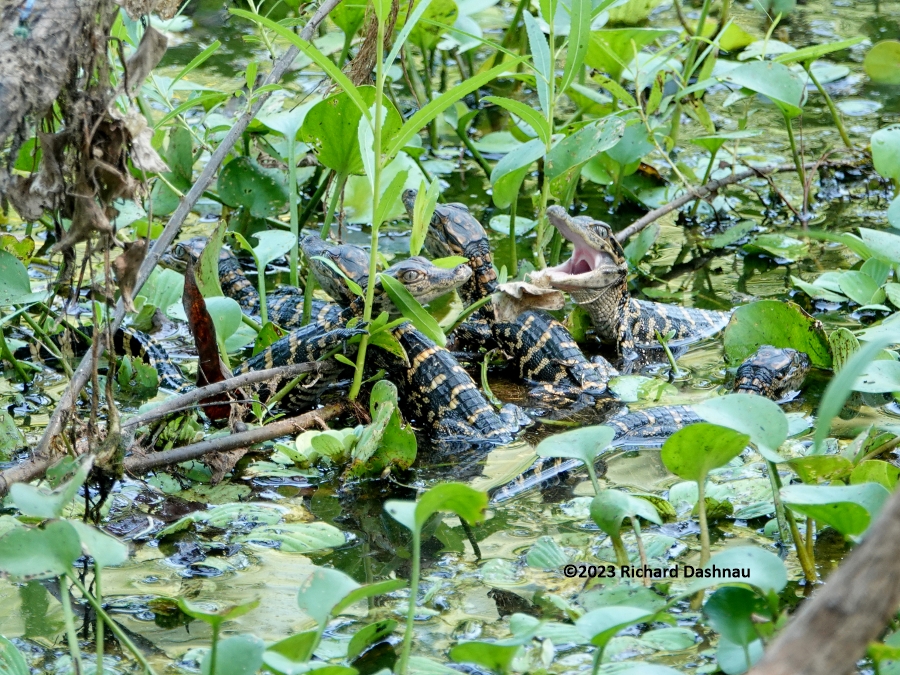



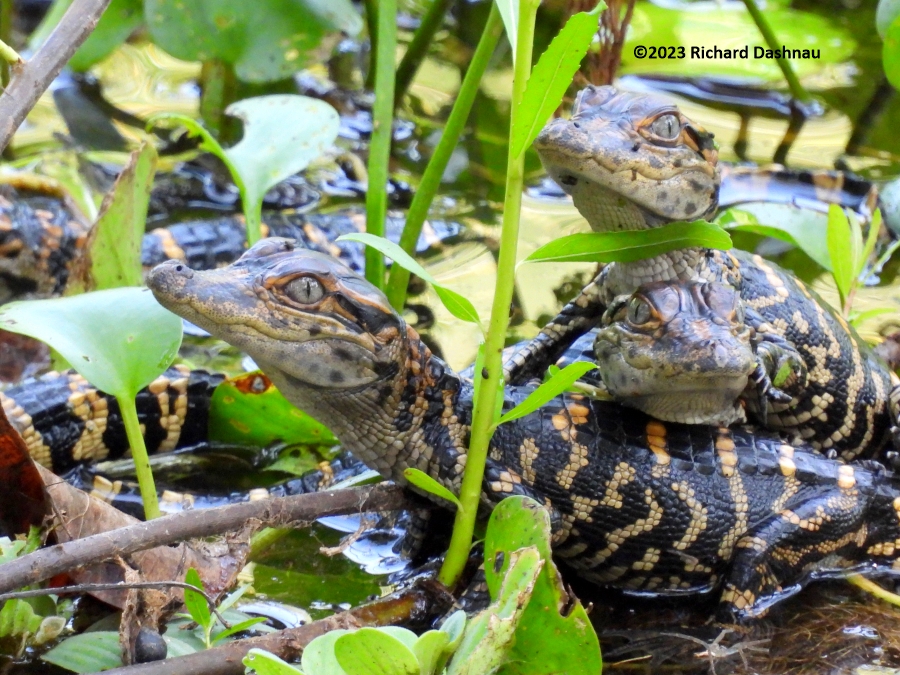
On 09/03/2023,
the pod was still under this fallen tree that was near Bird Box
#18. Compare with the images from a week before (just above)
and
it's easy to see how much
the water had receded. This time, I found the mother
alligator in the water on the other side of the fallen tree.


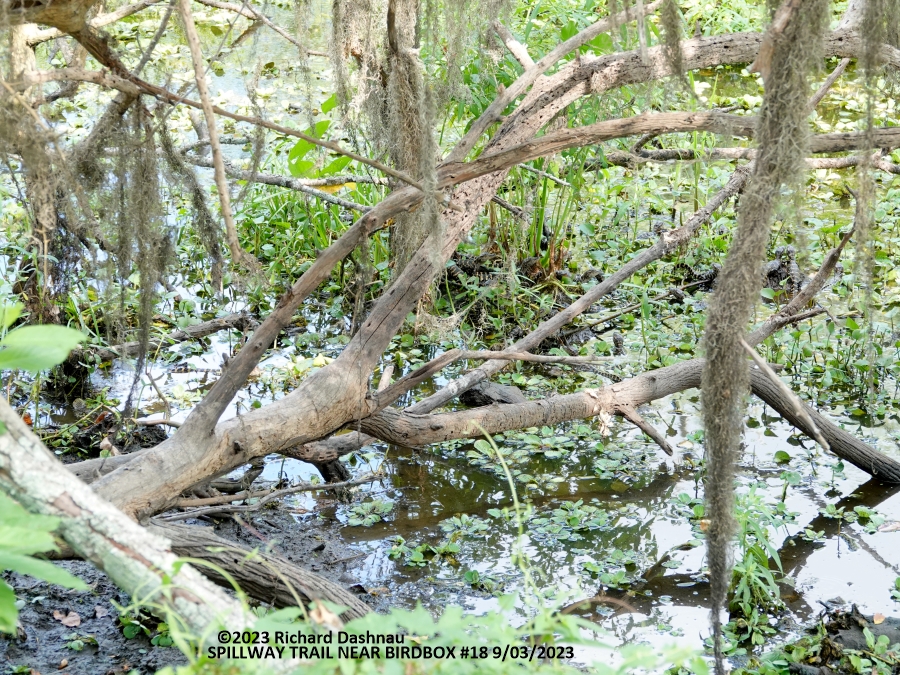
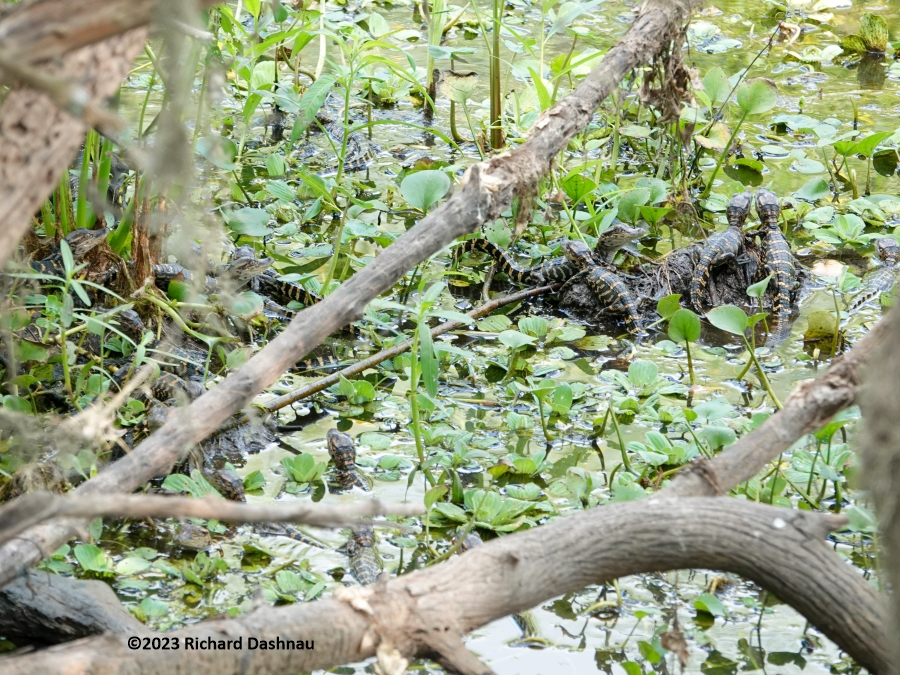



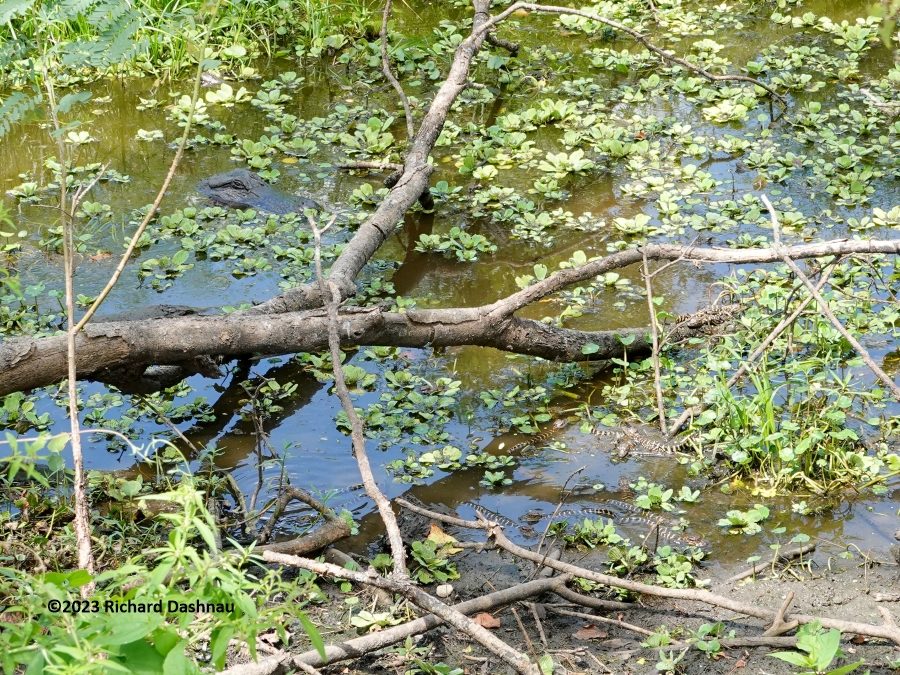



On 09/10/2023,
the pod (if it was the same pod) had moved about 100 yards further
West--closer to the Spillway Bridge. This new spot was just
in
front of where the other
alligator
nest in the area had been. There was a fallen tree there, also--but
it wasn't the same size as the one near Bird Box
#18. I
found the mother alligator in the water
on the other side of
the fallen tree from the babies.



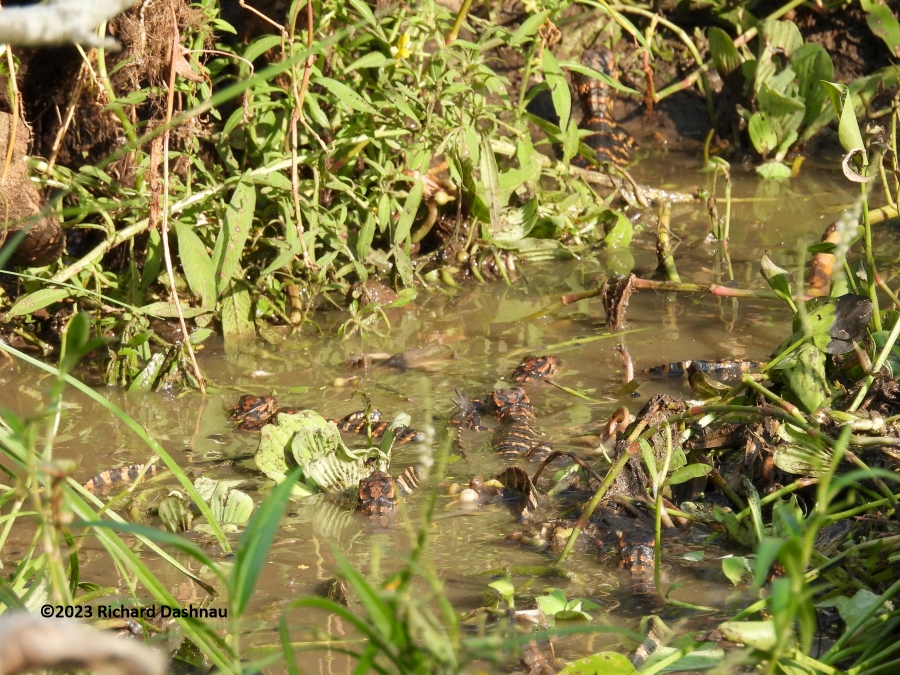



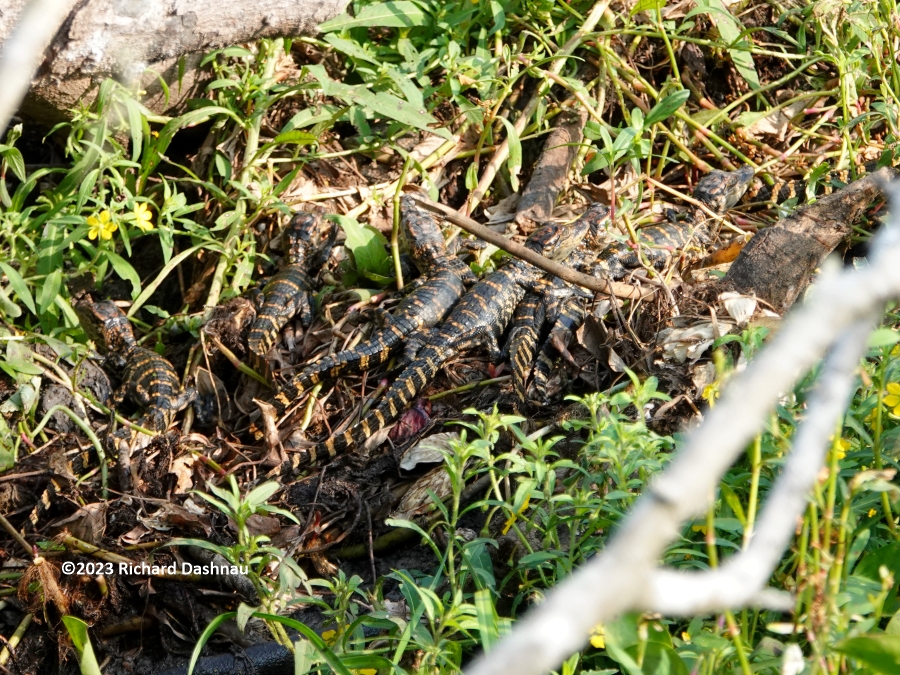



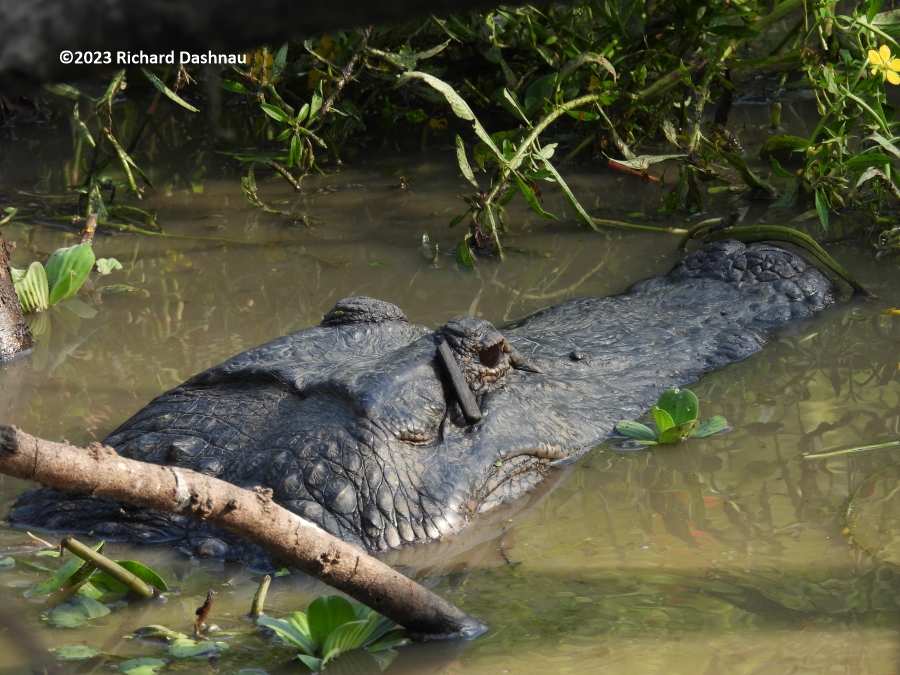
This
time, she was
doing the
"seining" behavior (which I show in more detail on
this page.), but didn't seem to have much
luck. When she started this, I noticed that the
baby alligators were outside of her
"current-generating" area. The images below are frames from
video filmed at the time. The
video showing
this behavior on this
day
is
here (uploaded 9/29/2023).
A Green
Heron (Butorides virescens)
appeared to take hunt for prey that might have been flushed
out by the alligator (last 3 images below).






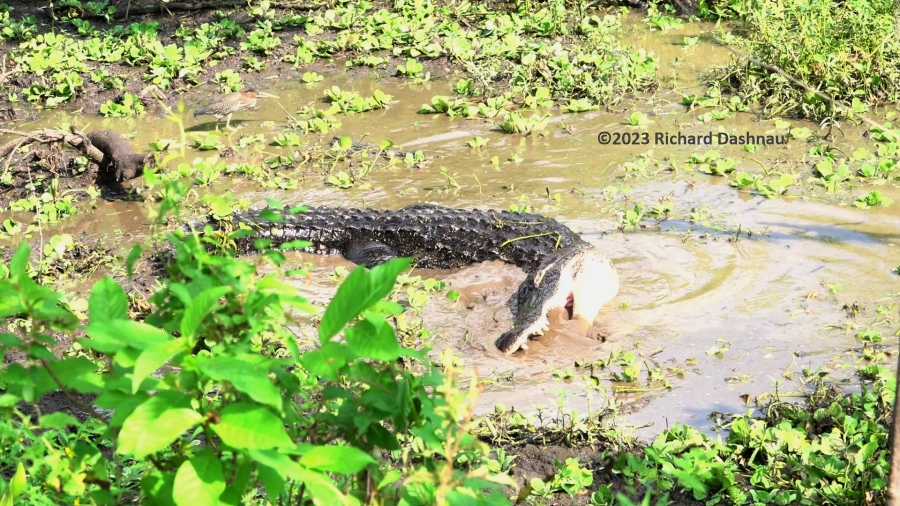
At Brazos Bend
State
Park 09/17/2023, 09/24/2023,
10/01/2023. I continued
watching the pod of baby alligators along the Spillway Trail. I
can't
say for
sure that I'd found the same
pod each time, although it probably was the same one. During that
time,
I
could see the water level in that area was lower each week.
The following images show the baby alligators (and sometimes their
mother) as I found them. I also shot some very short video clips
which
are linked below.
Note that the closeup images of the gators are telephoto shots,
taken
from at least 15 yards away. The wide shots (showing the general
area)
show how far away I
was, and also the general appearance of the area.
On 09/17/2023, the
pod was still near the nest by the Spillway
Bridge. I could only spend an hour near them, but I did find
the
babies, and could see
the adult alligator in
the water near the tree. These images clearly
show great differences in size among the baby alligators. Photos
don't
show it very well, but there were many babies
moving among the plants. I filmed some video to
show this, which I may upload later.



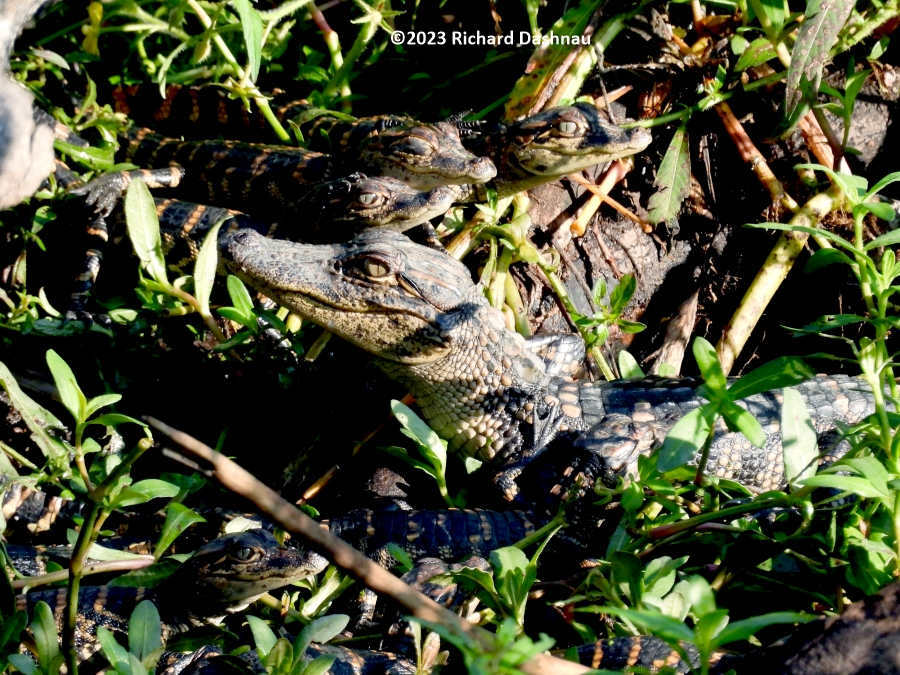



On
09/24/2023, the
pod was still near the nest by the Spillway
Bridge. I was there for at least 3 hours. There was even less
water. I'm showing a lot of images from that day
(some are from video I filmed, which is
here.), but I believe that together
they add context to the activities that
day. When I first approached the spot, a lot of larger gator
offspring were on the mud bank. I was
surprised when they all slid into the water--since I was still at
least
25 yards away, as usual.




The mom gator
appeared, and baby gators began climbing out of the water. But,
these
were hatchlings, probably from last August, and obviously smaller
than
the ones I'd
seen before. The longer shots show how low the water was, and can be
compared with pictures taken at earlier dates.



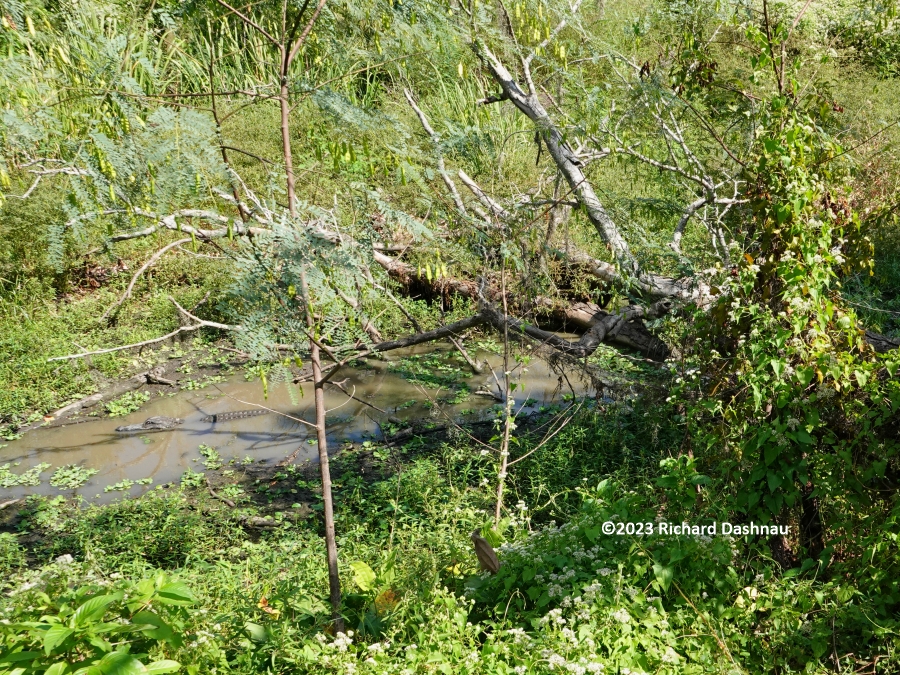
Mother
alligator
moved West, and eventually walked up to the trail. Some of the
babies
seemed to be aware of this, since they chirped, and moved to where
she'd
gone.



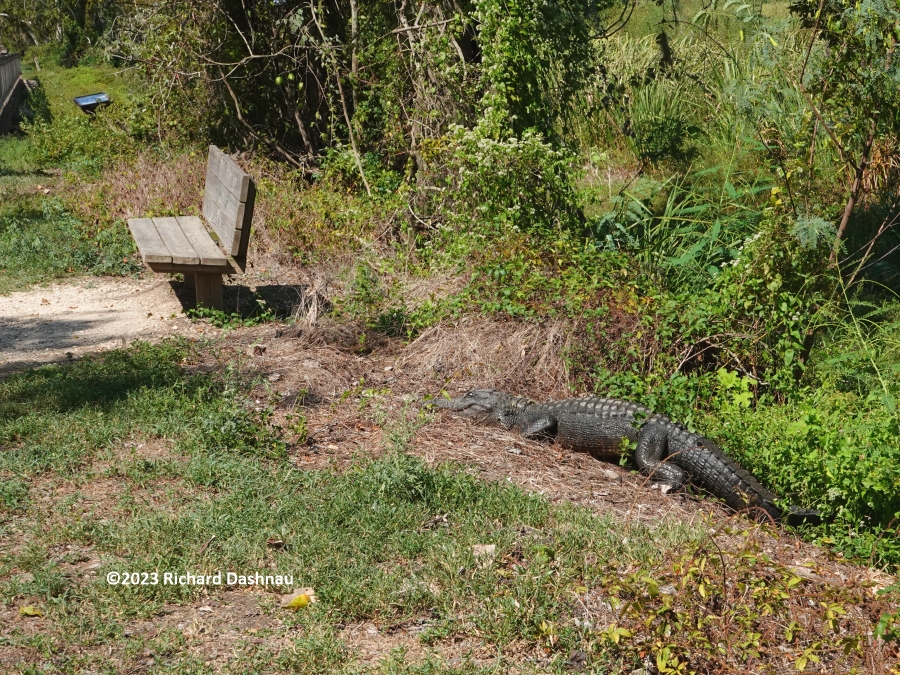
Some of the
images
below show the big difference in size between the young alligators.
I think the last image may show baby gators from
different hatchings over 3 years.



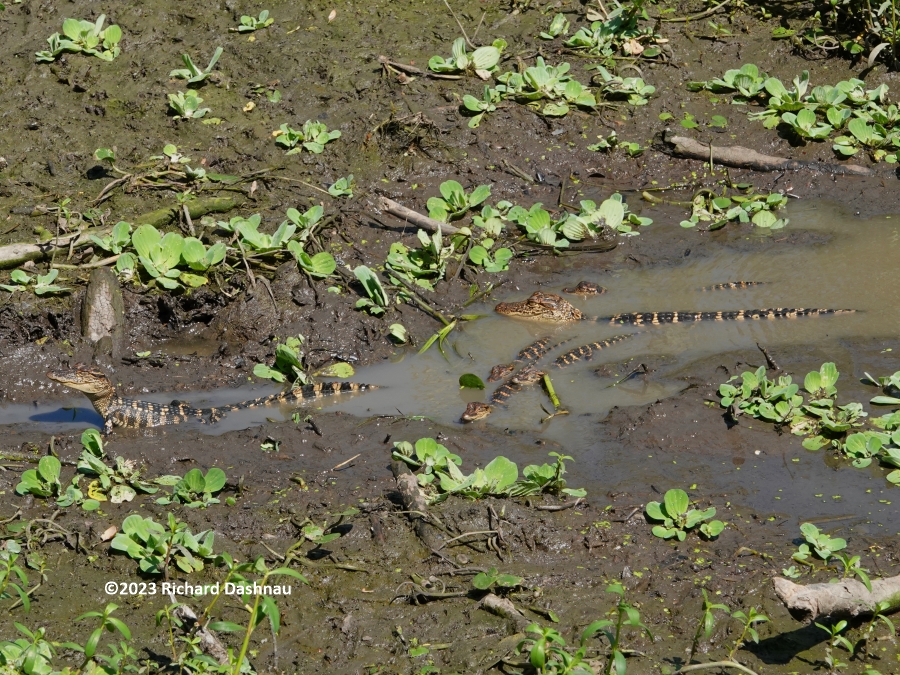
I assume the
adult
alligator is female-and their mother--because she is staying around
the
young alligators. It seems that one or both of her eyes are
damaged. She might
be blind.



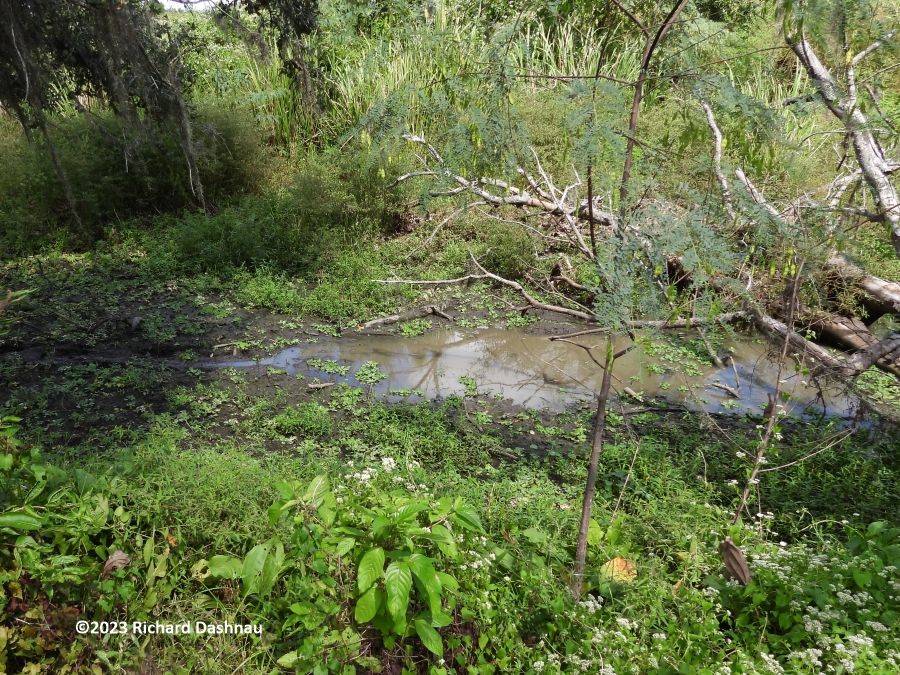
Mother gator
returned to the puddle. I hadn't noticed at the time, but from the
pictures it seems that the larger offspring moved further way. The
remaining hatchlings
didn't seem to care when the mother moved by.



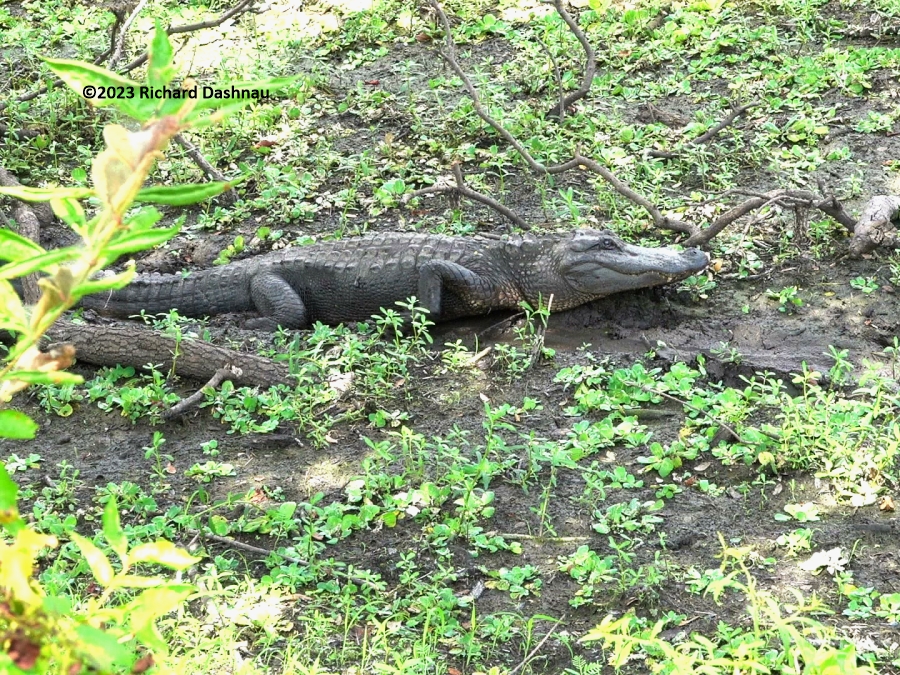



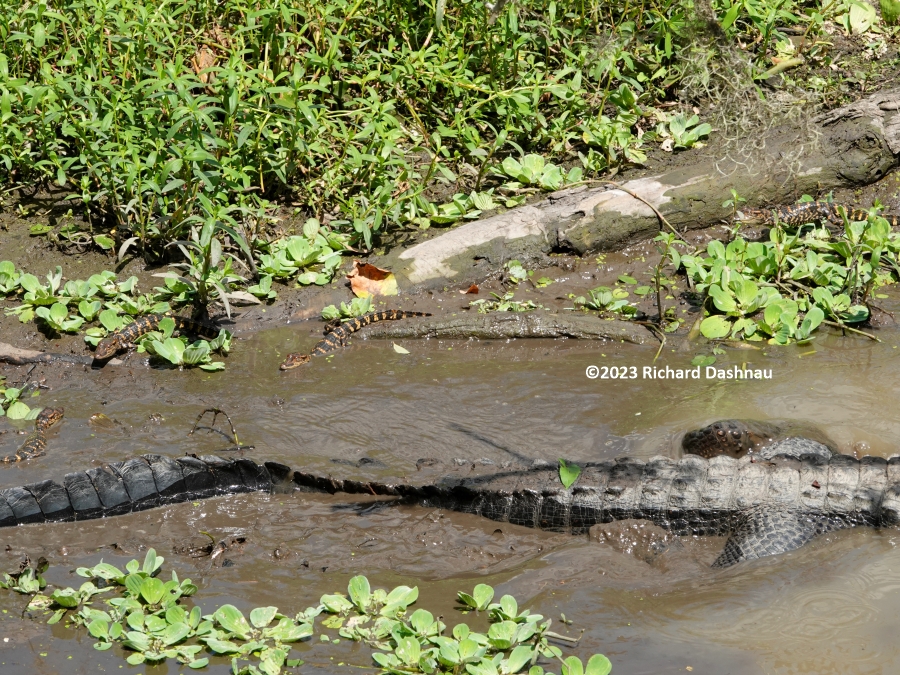
The mom gator
began agitating the water, and seemed to be digging with her rear
feet.
This was not the same as "seining" foraging behavior. She
was not moving
her forelegs, or trying to grasp at prey with her jaws. She
scraped with her back feet, and sometimes pushed water with her tail
(sort-of swimming in place). If you missed
the link above, the
video of this is
here. I
think this was
an effort to make the puddle deeper. It can
be compared with
this video of her doing
seining
behavior a few weeks
ago. Of course,
this is
only
a guess, but an informed one. The alligators NEVER tell me
what
they're doing, or why they do it.


On
10/01/2023, the
pod was still near the nest by the Spillway
Bridge. I was there for at least 3 hours. There was less
water than the week before. I'm
showing a lot of
images from that day (there's also some video I
filmed, which is here.), but I together they add perspective to
activities that
day. When I first approached the spot, many
of the babies-of various sizes(ages) were scattered
around. I was at least
25 yards away, as usual. Lighting in the images changed as
the sun moved across
the sky.
The 4th image below shows a nice size comparison between
babies--especially when I compare the size of their heads.



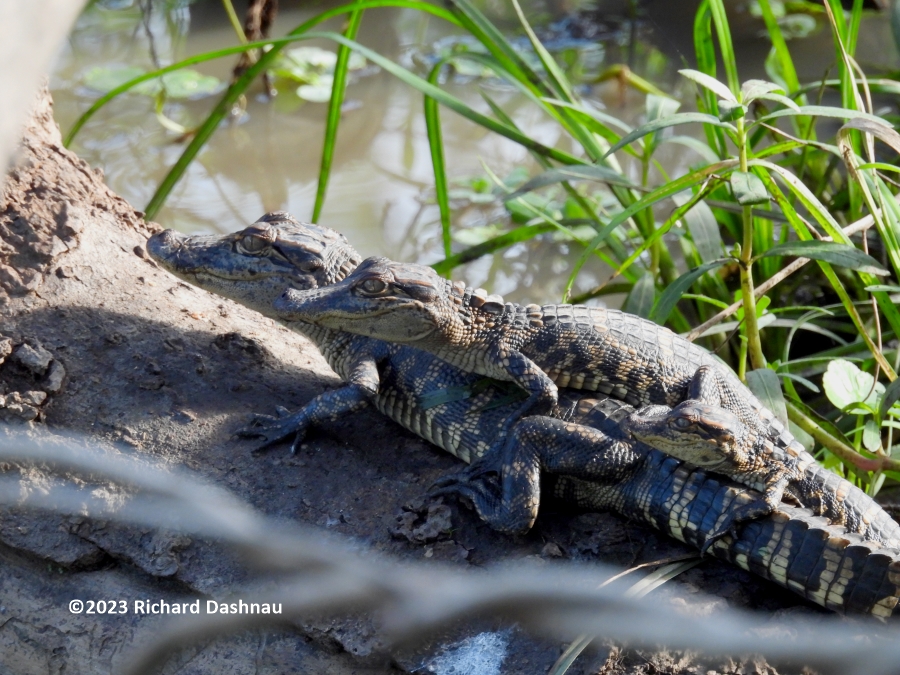
While
some babies rested on the mud on the left of the tree (West side),
others rested on the right side of the tree (East side).
There
was no way I could count all of the
babies as they moved in and out
of cover. While spending years watching pods of free baby
alligators, I've noticed that the babies seem to interact as a
"social"
group at
times. Babies talk to each other, they move as a
group, they share space; and seem to find comfort in piling
together.
It's only my opinion, but it seems a lot different than
if each one cared only for itself. Some of the best examples are the
images with a pile of larger babies...with the occasional tiny form
of
a hatchling resting among them.



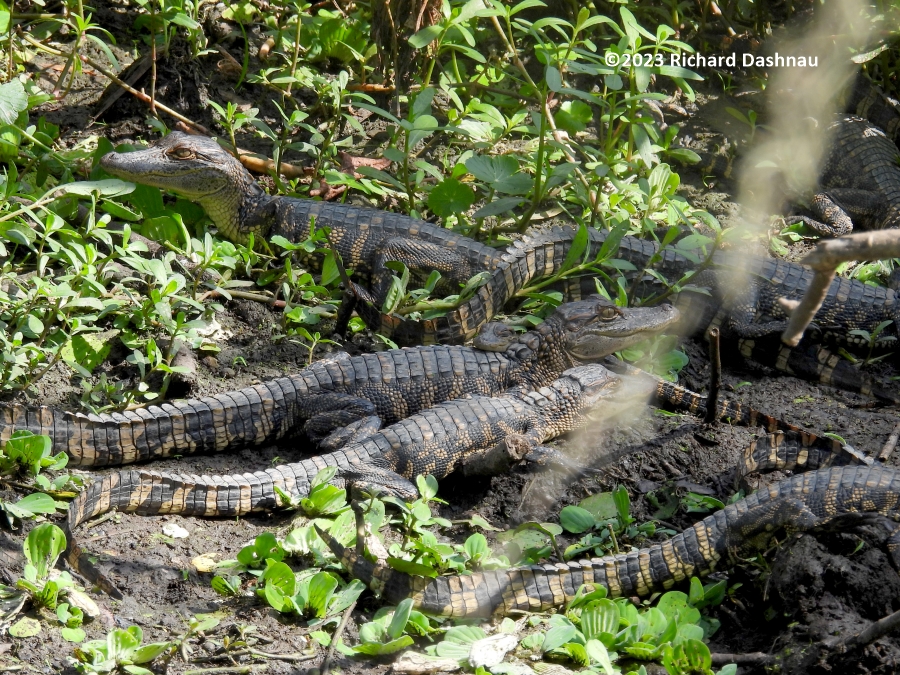
The
mother gator finally appeared, under the trunk of the tree.
Closeups of her head reveal that it was also covered with
mud.
This indicates that she had been digging.
I had further proof when I
saw movements that showed the adult was digging under water in that
spot. The 4th
image below shows the turbulance as she was working.
I got
short
video, which is here.




This
last row of pictures show the mother in the water near one of the
recent
hatchlings (hatched sometime mid-August 2023). Then, just the
top
of mom's mud-covered
head, and then some of the babies on the mud in
the foreground, with mom's head barely submerged in the background.
There's no way someone that just walked up
would know that she was there.
I've been extremely lucky
to have seen alligators living in a natural environment for the last
20+ years. It's a real gift to be able to hang
around a mother gator and her pod
for hours at a time.
During those hours, I'm also interpreting Natural History for
park visitors that pass by. It's easy to lose track of how
much time has expired; and I get
to learn from everything I witnessed.
The last two summers have been hard on BBSP (and all of
Texas); and the alligators have-in their majestic, stoic way-had to
deal
with the changes to their environment.
This mother alligator has been working hard, and her trials
weren't over. (That's for a later update.)



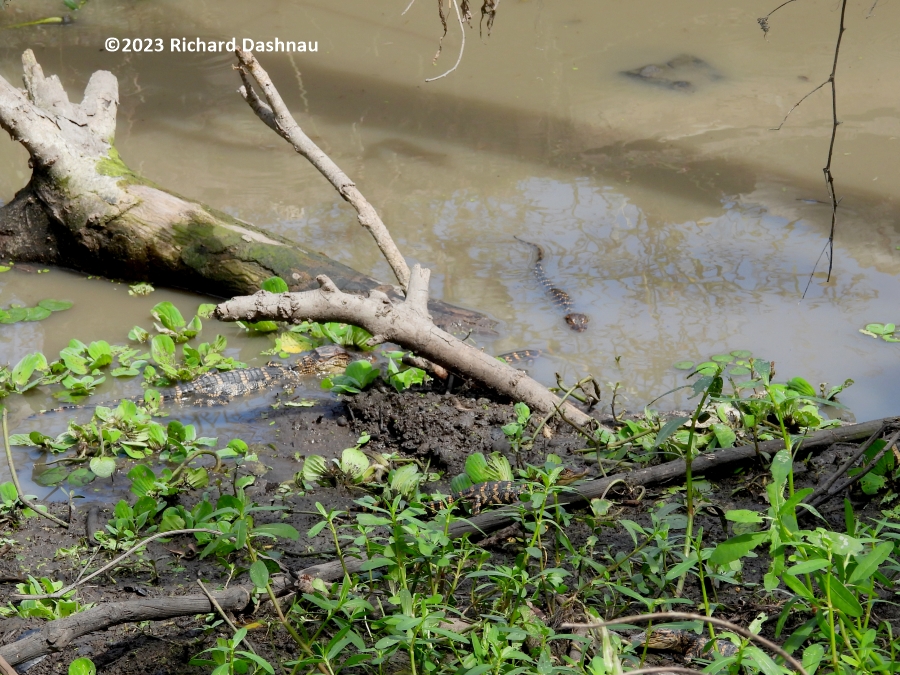
At Brazos Bend
State
Park 10/08/2023. I continued
watching the pod of baby alligators along the Spillway Trail. I
can't
say for sure that I'd found the same
pod each time,
although it probably was the same one.
I've found this interesting report, which describes the
activities of
nesting alligator. Many of the behaviors I saw at BBSP are also
described in that paper.
It is "Observations
on Maternal Behavior of the
American Alligator, Alligator mississippiensis" by R. Howard
Hunt and Myrna E. Watanabe
On 10/08/2023,
When
I
visited the fallen tree at about 9am, I could only find the adult
gator. I couldn't find any babies. So I went to Elm Lake. I
met
a group of park
visitors near Elm Lake that told me they had seen
baby alligators near the fallen
tree. Then
they
described a bit of drama when a "big grey bird"
appeared. When I
asked if the bird had caught any of the babies,
they told me that the mother gator had chased it off before
it could
get any of them. I identified the big bird a Great Blue
Heron from their photos. I
returned
to the tree at 11am. Some of the events described
below were captured with video and that can be
seen here.
I
could see a few baby gators under the tree on the far bank
(where
I've seen the mother alligator digging). Closer
viewing
revealed more babies in the water, so I
decided to stay near the pod
again. During the next hour, more babies left the water to climb
on that bank, and onto branches on the other side of the
tree.
The babies
of varying ages piled onto the various surfaces, and onto
each other. More time passed as the babies basked and
shifted around, and basked, and groups of park
visitors enjoyed the
view with me. Until....12:50pm.




At that time,
a
Great Blue Heron (Ardea
herodias)
landed on
the end of branches of the fallen tree-- about 6 feet above the
alligators. Some of the babies splashed into the
water even though the Heron
had landed far out of reach. But many other babies
remained
out of the water. [12:50 to 1:50 to 2:50 =2
hrs so
to 2:20 = 1.5 hours]
By this time, some of babies had been
chirping, and I'm sure the Heron could hear them. The Heron
began stalking the babies. It landed high on the bank, and then
slowly
paced to the right side of the tree. Then it paced down the bank,
stepping carefully and watching for movement. Heron
slowly...slowly...approached the water. It
appeared to focus
on something, and moved into "stabbing position", by crouching and
pulling its neck into a tight "s" curve. We watched as the heron
paused...and
waited...and waited....



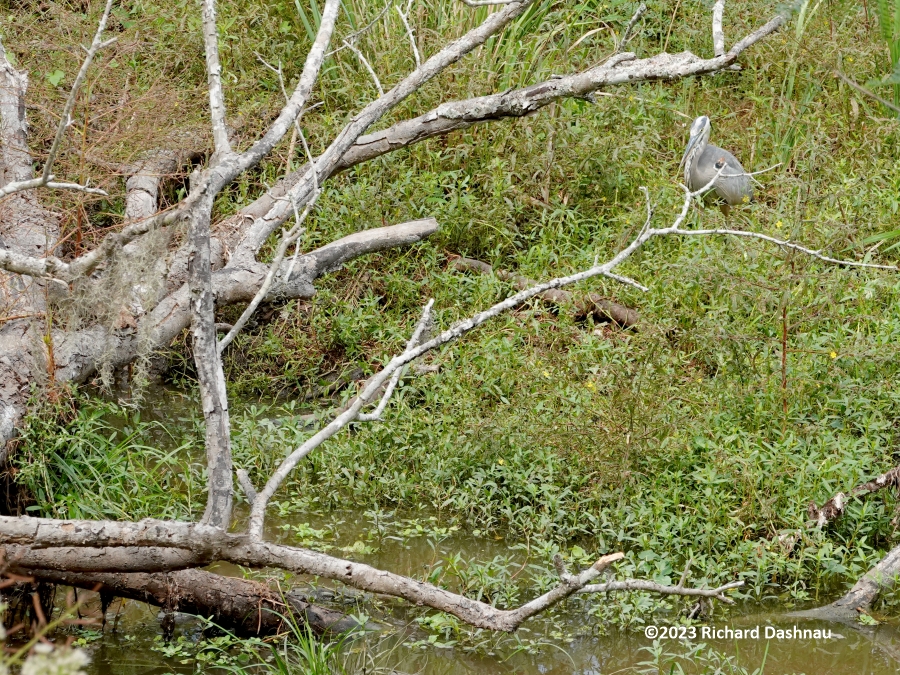
...and
then, while still crouched, it walked backwards and moved away from
the
water. We watched the Heron try to approach the baby gators,
moving to one side of the
tree, and then the other.



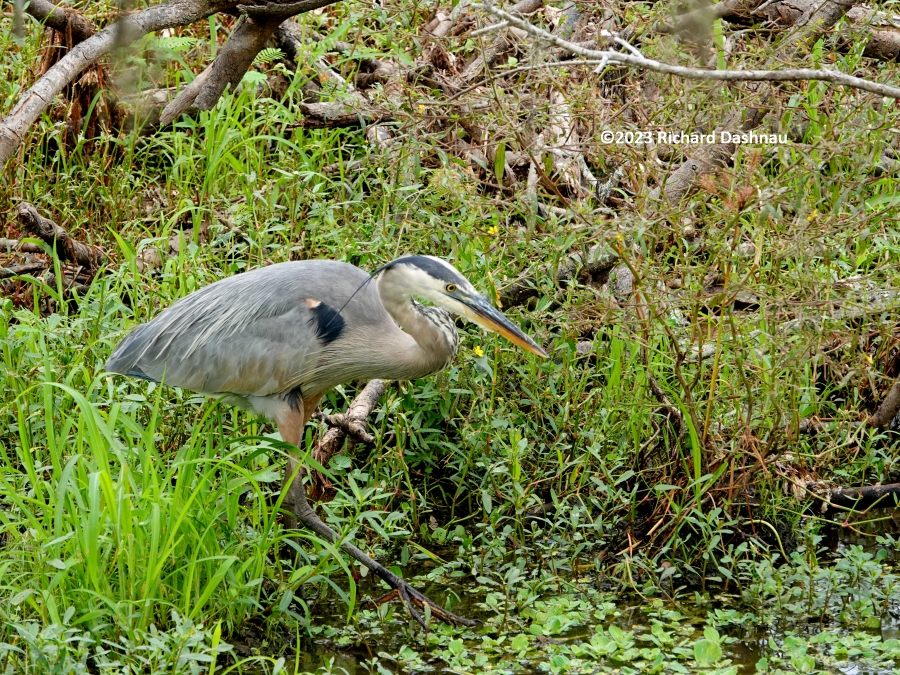
About 2:05pm,
while the heron was on the left side of the tree but still pretty
far
away, the mom alligator lunged out from under the tree. It rested on
the bank while the
Heron walked up and around to the right side of the
tree.



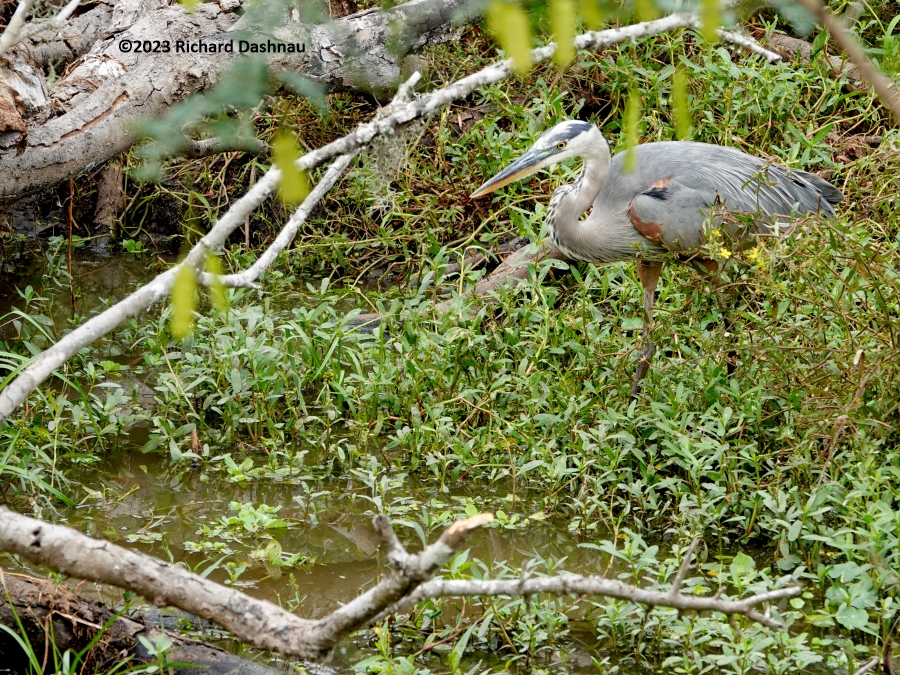
This time, it
moved down to the water, paced into the
water, slowly squatted and peered under the
tree--and snatched
one of the babies!
It stabbed under the tree,
unfurled its wings for balance, closed
its wings, turned around, and leapt into the air. (I can time it at
37.153 to
37.904 seconds = .75sec, 45frames);
and flew off (Frame timing 42.876; or about 5 seconds from when it
grabbed the baby gator.).
The images below are frame grabs from video, which can be seen here.



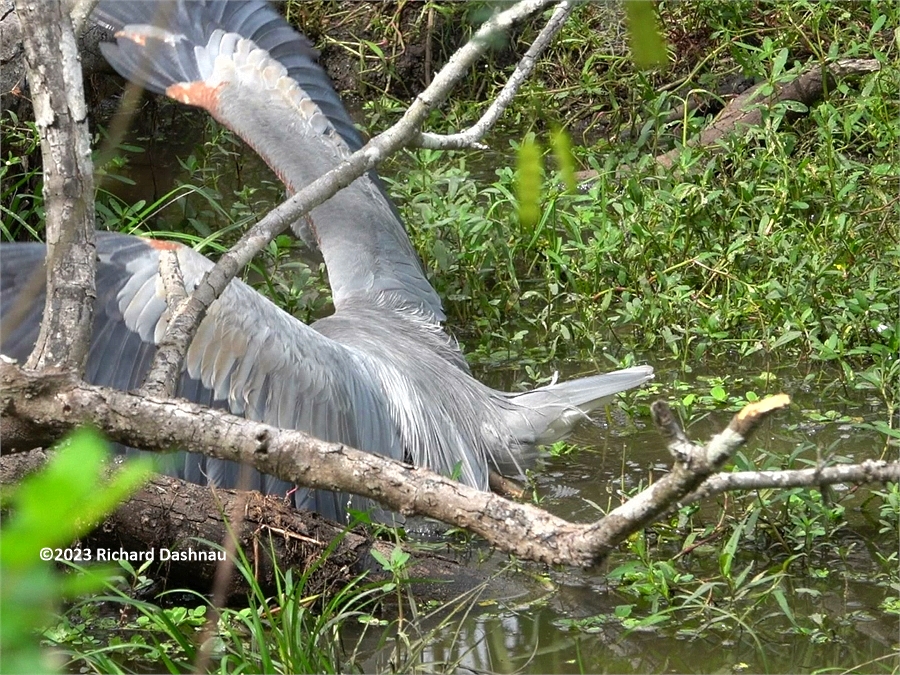



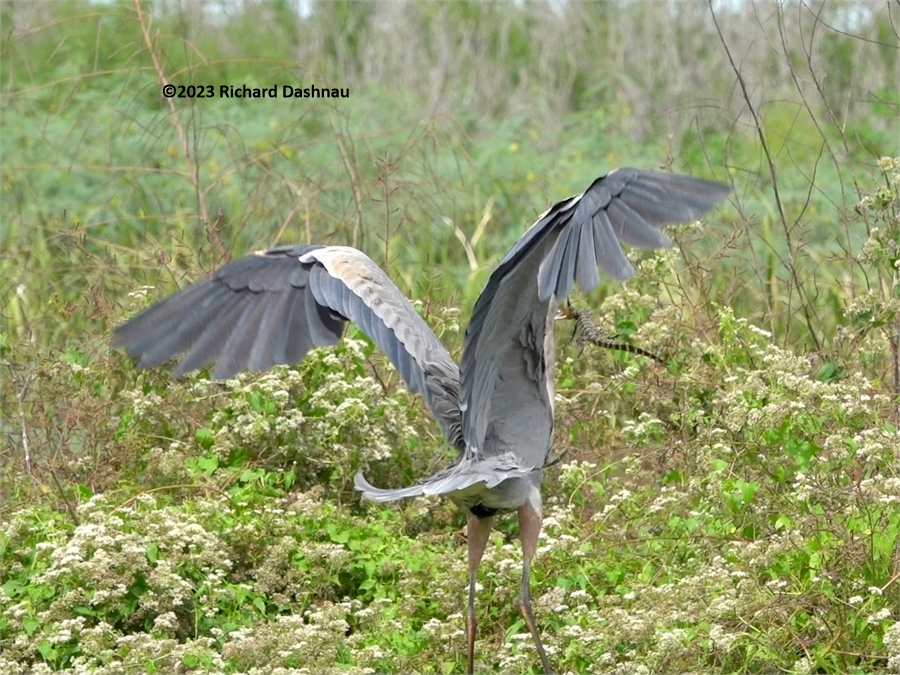



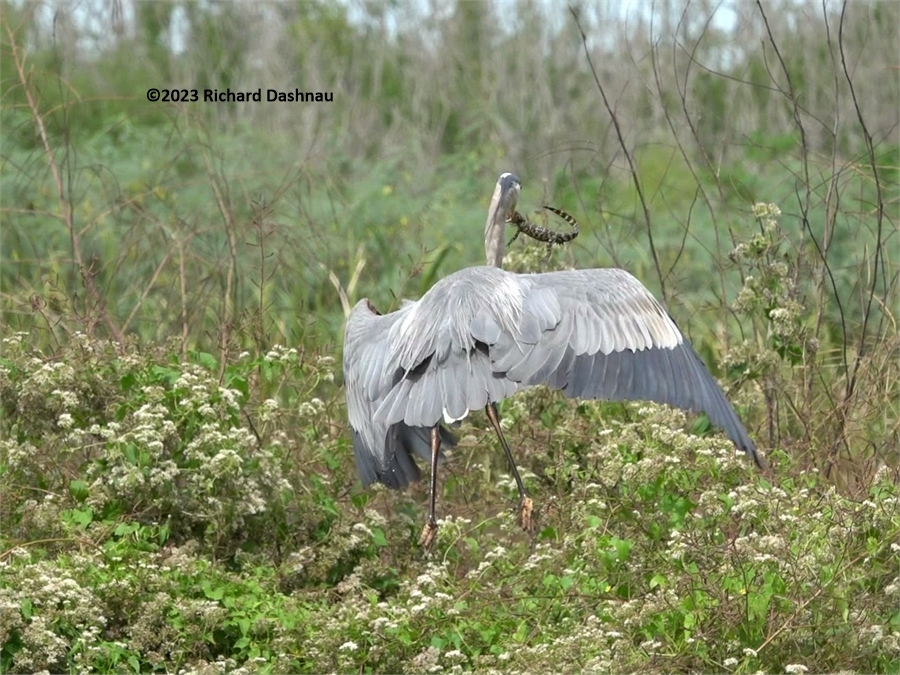
When I looked
back
to the tree after losing sight of the Heron, mom
alligator had lunged out to the right side of the tree. Mom gator was
not
pleased. We only visit a day at
a
time, a few hours at a time. I imagine that this alligator has to
deal
with this kind of attack many times daily. This pod's struggles
demonstrate why so many alligator
offspring may not survive the first few years.


I've been
extremely lucky
to watch alligators living in a natural environment for the last
20+ years. It's a real gift to be able to hang
around a mother gator and her pod
for hours at a time.
During those hours, I'm also interpreting Natural History for
park visitors that pass by. It's easy to lose track of how
much time has expired; and I get
to learn from everything I witnessed.
The last two summers have been hard on BBSP (and all of
Texas); and the alligators have--in their majestic, stoic way--had
to
deal
with
the changes to their environment.
At
Brazos Bend State Park
10/15/2023
I
was by the alligator pod at the East end of the Spillway Bridge. The
water level had decreased some from the week
before. On this
day, there was no drama, so I'm sharing some pictures
of the pod enjoying the sun. As usual, it took a while for the babies
to appear, but I did at least see the mother
alligator. Some of the
closeup images of her head show traces of gray mud, so she was
apparently still digging.



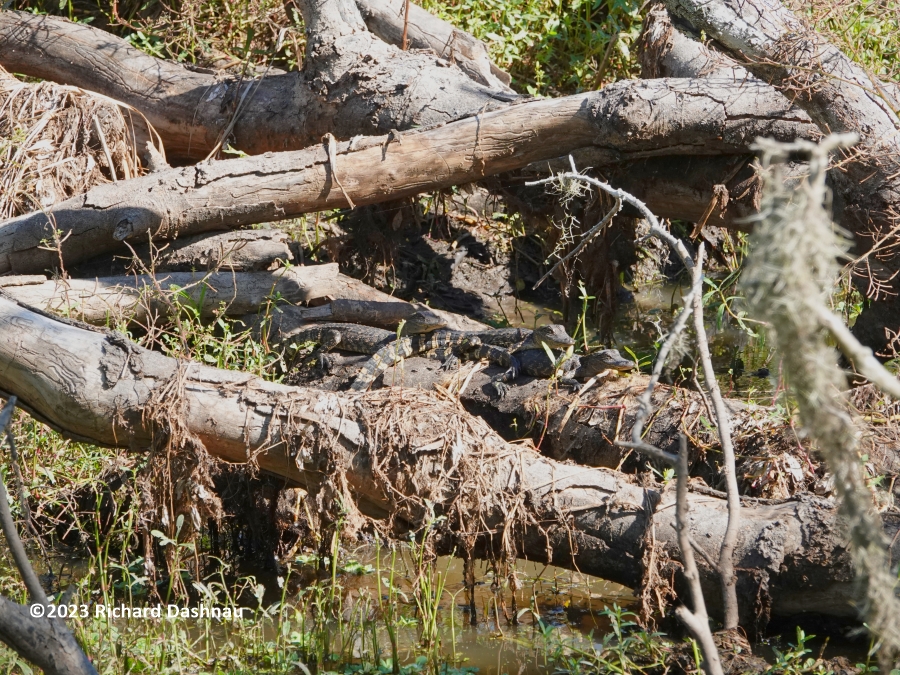



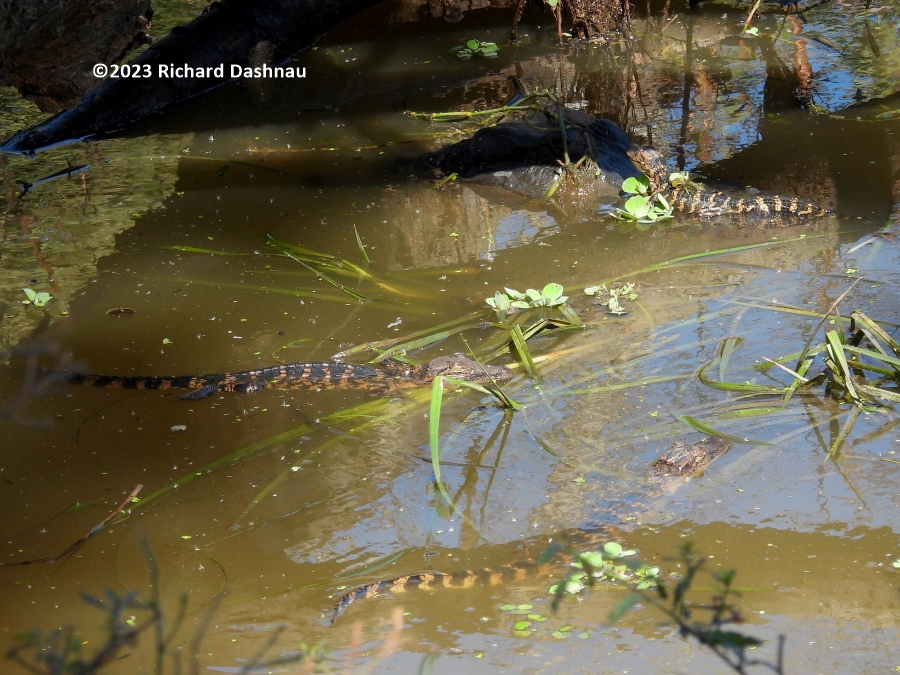
From
11:00am to 1:30pm, the alligators shifted around, changing places on
the branches and on the bank. They were even joined on the log by a
large turtle, a
red-eared slider (Trachemys
scripta elegans), for a while. But it was pushed off the
log by a pile
of baby alligators.



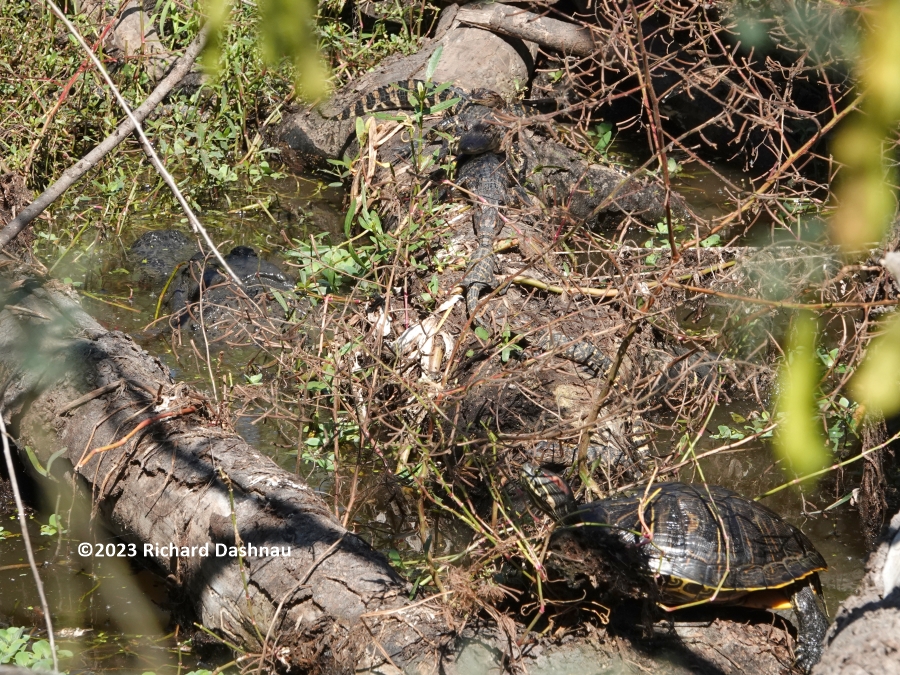
The
images below show one of the new hatchings being made into a
"sandwich"
by climbing on one of the older babies; and then having
another
older on climb on top.
I am still impressed by how comfortable a
pod of babies is with each other. The "share" space by piling on each
other, instead of competing for it by pushing others away.
They aren't quite as generous with their food, though. One will try to
steal from another.



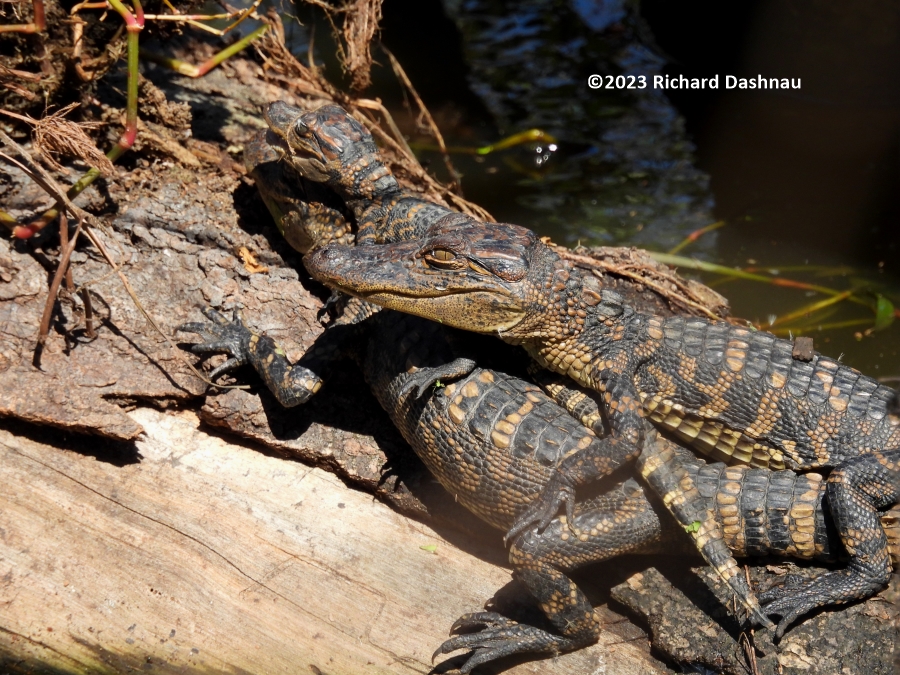
At Brazos Bend State Park
10/22/2023
I
was by the alligator pod at the East end of the Spillway Bridge.
Between 9:07am - 9:52am mom and babies
were
already out, and under the tree trunk. The water had gone down more
since last week, leaving lots of clearance under the trunk, and
exposing more bank.




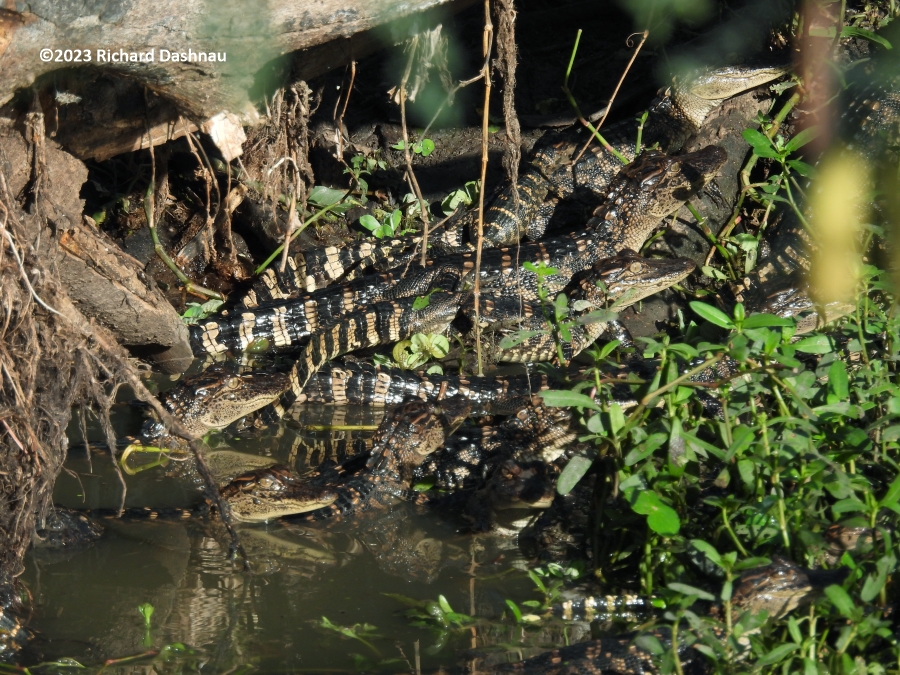




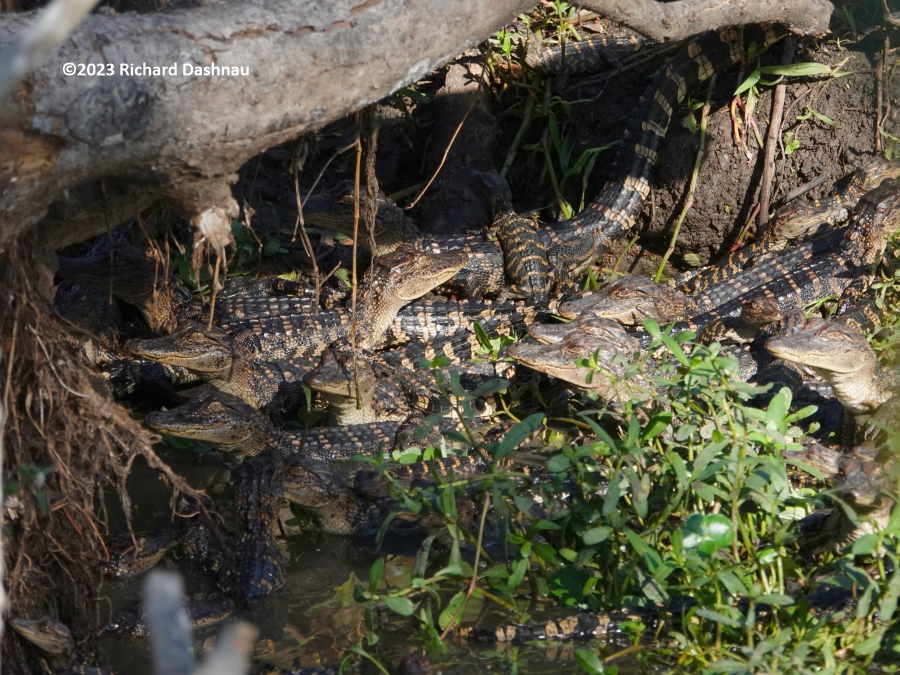
From
10:30am - 12:00pm:
A Great Blue Heron appeared higher on the bank, then walked
towards the baby pile. The babies scattered, so the heron
moved back and up
around
to the other side of the tree. It moved very quietly as usual, and I
didn't see any reaction from the mother or hear the babies.
The
heron stalked the area, going
from one side
of the tree to the other by moving up and down the bank. On one trip
down, the heron grabbed and ate a dragonfly (the video shows 10:57).
The heron was pretty
far up the bank and away from the water.




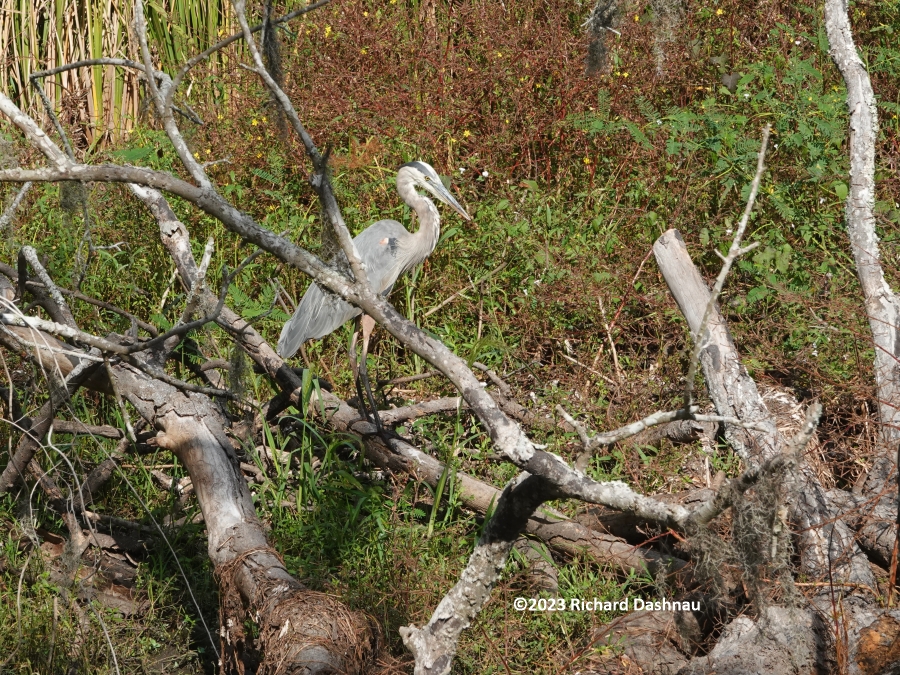
About a minute later, mom
gator rushed onto the bank in front of the heron. I thought
this was odd, since I'm pretty sure
she's almost blind, and the heron was pretty far
away. Maybe
she heard
the capture and crunching of the dragonfly being eaten (Shown, but not
heard, in
this video.)
The Heron quietly
moved further up
the bank
and
behind some plants. Mom gator slid back into the water and under
the tree. The heron landed on top of the
usual vantage point left of the tree, and then flew off.




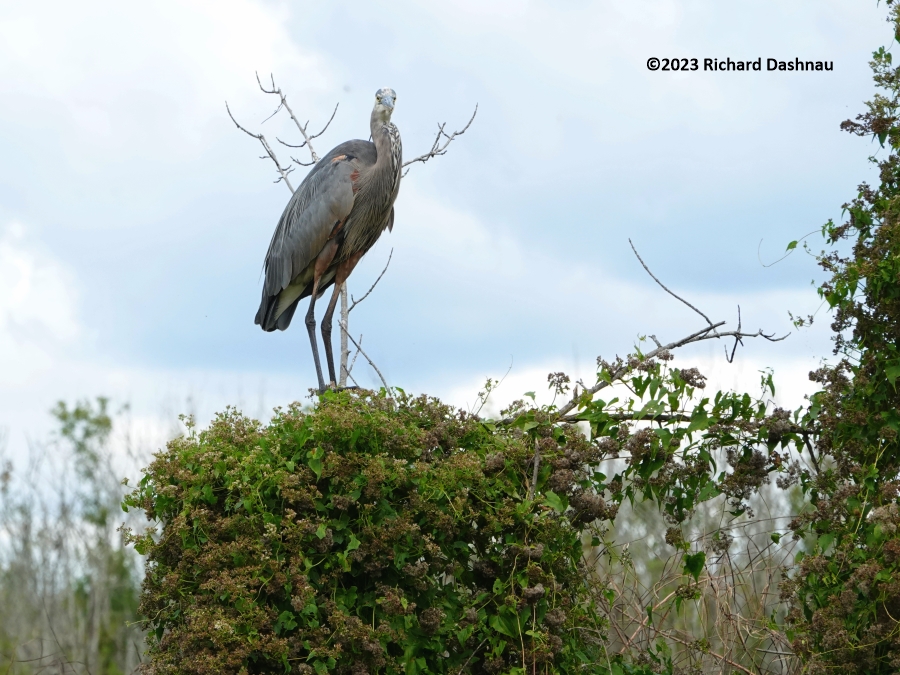
Starting at 12:30pm the babies began to surface and started to climb
out of the water. By 2:30, mom was on
the bank, with babies piled on top of her and on top of
surrounding branches.




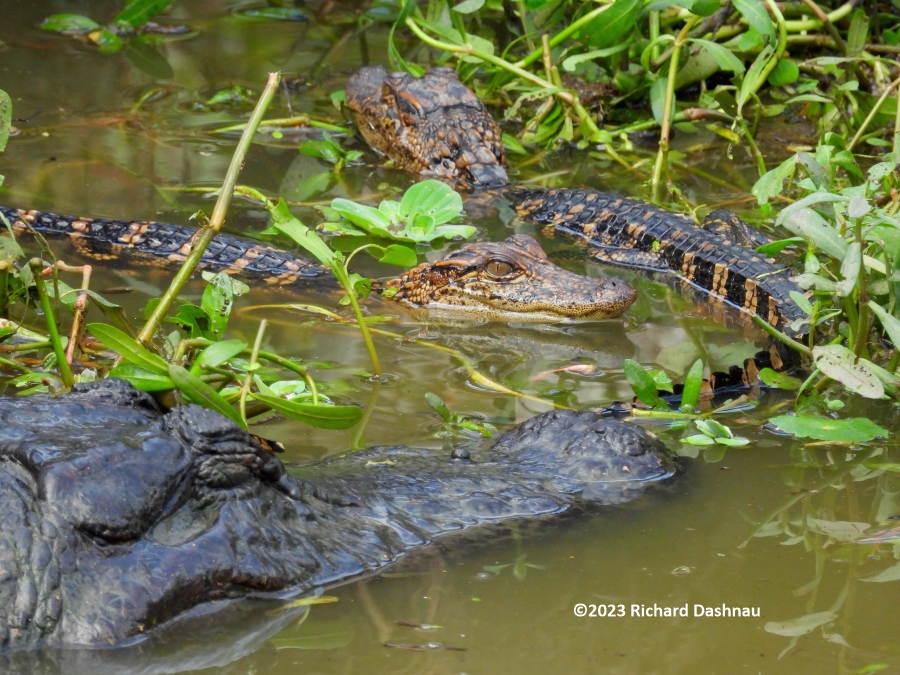
The
line of images below are of the same group, shown at different focus
ranges. I really liked the image, and thought others would, too.
Some of the events described
here were captured on video which I have here. The
history of this pod up to
this day is shown on
this page.




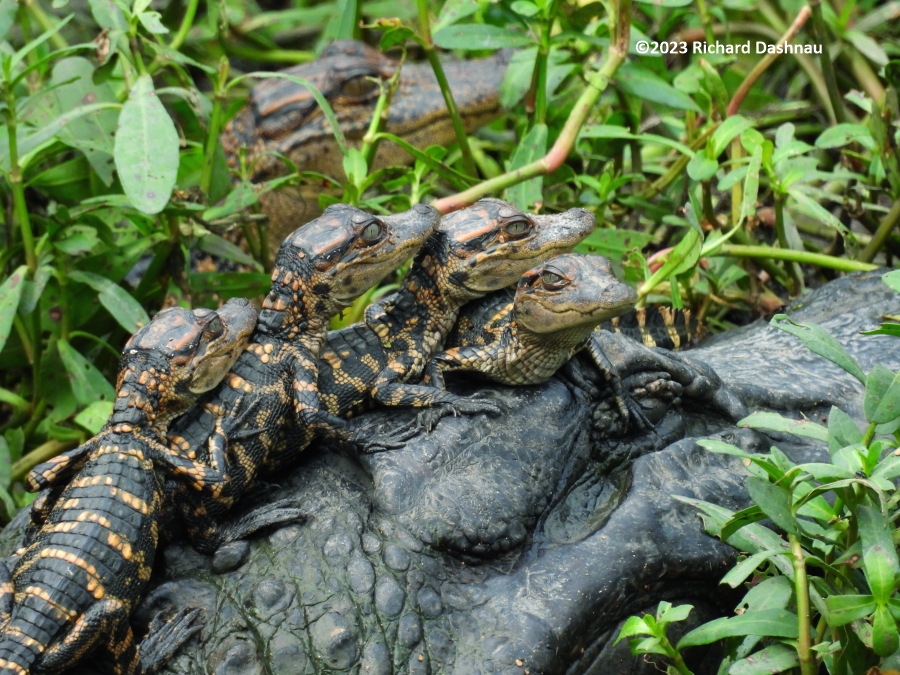
11/05/2023
We still
haven't gotten any rain.
The puddle near
the pod on the trail by the Spillway Bridge has gotten even smaller.
Baby gators
were already out by 9:20, and I could see mom gator's
head, too. That's not a big surprise, considering the warm weather,
and shallow water. Mom gator climbed
partially onto far bank,
while the babies climbed out onto mud, branches, and various other
objects. About 15 minutes later, some of the babies had
climbed
onto mom.
(There's
also video of all that's
described below, and thats at
this link.)




By 10:34 mom's front legs and
head were up on the bank, but
most of her body was also exposed in the shallow water-and 6
babies were on her back. Over the
next hour,
the mom gator climbed all the way
out onto the bank, and turned to be parallel with the bank.
Baby gators
started climbing on her back, until a small pile had formed.
All
was comfortable and restful until 11:30--when a Great Blue
heron
landed high on the bank about 10 yards above the mom and babies to the
right of the fallen tree.




Even at
that distance, many of
the
babies jumped off mom's back to hid in the water among the branches.
The heron stayed high on the bank and slowly walked towards
the
tree through the plants. Then it stopped at the top of
the
tree while hidden behind a stand of giant cutgrass and
waited for a while. It started walking East (right
of the
tree) about 20 minutes later. The Heron walked far out to
the right,
and circled down towards the remaining puddle.




As it
continued its
circle on into the mud in front of us, the mom gator suddenly
twisted partly around with jaws open but facing
away from the
Heron--which was a few
yards away. The Heron was startled by
the alligator's jerk, but then moved towards the water under
the tree.
It paused for a few minutes and watched for movement under
the
tree. At the I thought it seemed odd the the mom gator had lunged away from
the Heron if it had been triggered by the Heron moving.




When the
mother lunged, she threw
the remaining babies
off her back and they went into cover. While I was trying to
isolate the section of video showing the babies
falling off, I discovered something very interesting.




I've circled the
surprise in the images below. It's a
mating pair of Dragonflies (Green Darners) that were flying near the
alligator. These images are frame grabs from the
video,
and I don't think I'd have found the dragonflies if I hadn't noticed
them moving between images. I am sure that the mother is
visually-impaired. Yet she seems to be
following the dragonflies through the air. The video
footage clearly shows it. This may verify my theory that mom
gator is using hearing to locate her target--whether it's
a Heron, or a pair of Dragonflies in flight.




The
Heron continued walking, then
it jumped onto the tree, and walked on top of the trunk and
the branches as it looked for baby gators. The Heron crossed to the
left
side of the tree, and searched the mud on that side. It
circled the
shrunken puddle to the left, and crossed to the opposite bank and up
into the branches, turned and came
back down the that side of the
puddle. The Heron searched among the branches for
20 minutes and
flew off without a prize. But first it looked everywhere, moving with
impressive stealth as it climbed on and around the
tree.




The
Heron
noticed movement of the mother gator under the tree--which
probably caused the big ripples in the water. The Heron moved
closer to the movement, then
seemed to decide not to continue.




The
images below show the mother
alligator as she moved in the shadows, probably trying to locate the
marauding Heron. Some of
the babies were also
visible near the
tree, but the Heron didn't go near those.




From
then, over the next 2 hours, the mom gator and babies relaxed again.
She
remained on the bank, and the babies started climbing onto her back
and
surrounding area.
When I left there were 9 babies on her back.




I
take the time to record days like this, because they demonstrate
behaviors when two different species from the ancient line of
archosaurs interact. This was also a good
example of how someone
(like me) can be unaware all of the items that might influence animal
behavior. My assumption that the main driver of the mother
alligator's
behavior was the Heron that was hunting its young--might
be have been disproved by the mother's being triggered by the romantic
Dragonflies.
11/12/2023,
11/19/2023,
11/26/2023.
We got
some rain during these weeks. I'm adding this quick update to add to
the growing record of this alligator pod.
The images
below show that the water has risen since 11/06/23 (above). What
the images don't
show is any of the baby alligator or their mother. I stopped
when I passed by, on some
days
at least twice, and I didn't see them, and didn't hear any baby gators
chirping, either. I'm adding this to the history (on 2/20/24)
because it probably influenced the
updates to follow.



12/03/2023.
I
was stopped by the tree, and watching for the pod; when a park visitor
coming from the East said: "Look! Baby alligators!" I turned around
and
saw that
they
were looking on the North Side of the trail. The mom gator was there,
along with the pod. I felt pretty foolish when I realized that they
had probably been there during
the previous weeks I'd been looking near the fallen tree.
They had crossed the trail and moved a bit
further East. This was a total movement of about 40 yards from the
fallen tree where the pod had been. As
the pictures show,
there is a lot less "major" cover (no large
branches). The vegetation in the images is floating on top
of the
water. There is at least
1 foot of clear water under the mats.
The
snarled nature of the plants above the surface also offers lots of
hiding places.



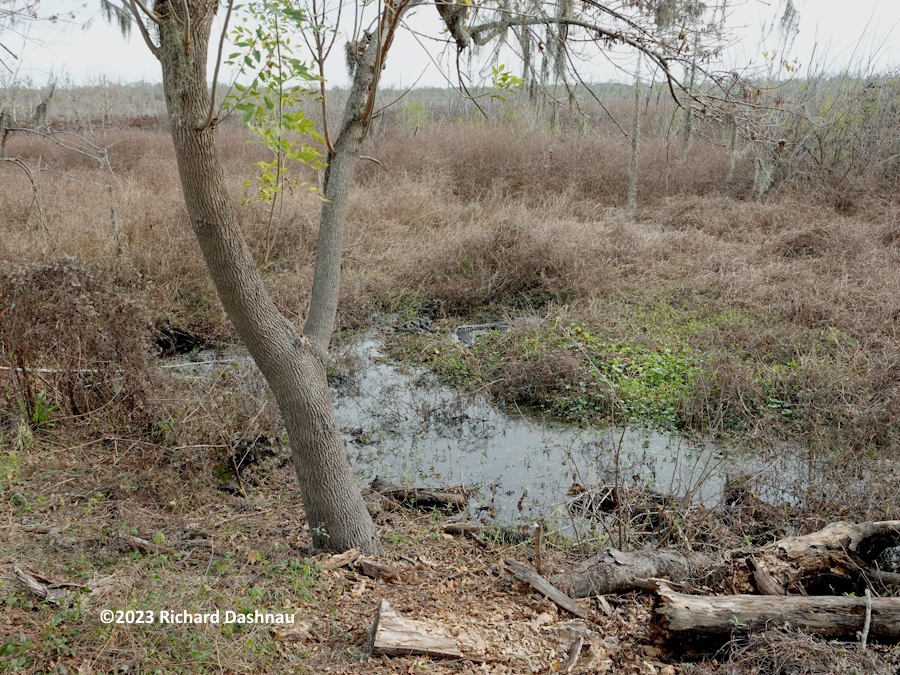
A
few people have asked how I know this is the same female. First, it's
unlikely that there'd be another pod of alligators with such varied
sizes-along with the mother of
the same size-so close to wear the other one was. Second, although I
didn't take pictures of her eyes on this
day, I did examine them through binoculars, and they are both
damaged. This showed me that she was the same alligator.
Since I had seen evidence of the mother alligator working on the area
around the tree by deepening the
puddle
(shown in earlier post above); and by digging something (chamber,
burrow, den) under the far bank (showed in earlier post above). I'd
considered this an
"investment" by the alligator, and a possible
indication she might stay for the winter. Her relocation was
just
another example of how animals make their own decisions,
for their
own reasons. She could have moved because the water was too deep
over her burrow, or the submerged branches were hard to navigate once
they were
submerged, or even the repeated visits by the Herons
were too stressful. She, like all the other animal life, did not
tell me why. She didn't tell me she was moving, either.
This
is the last update about this mother and her pod for this year (2023).
However, she is still around in 2024, and there are more updates of
her
on
this page.



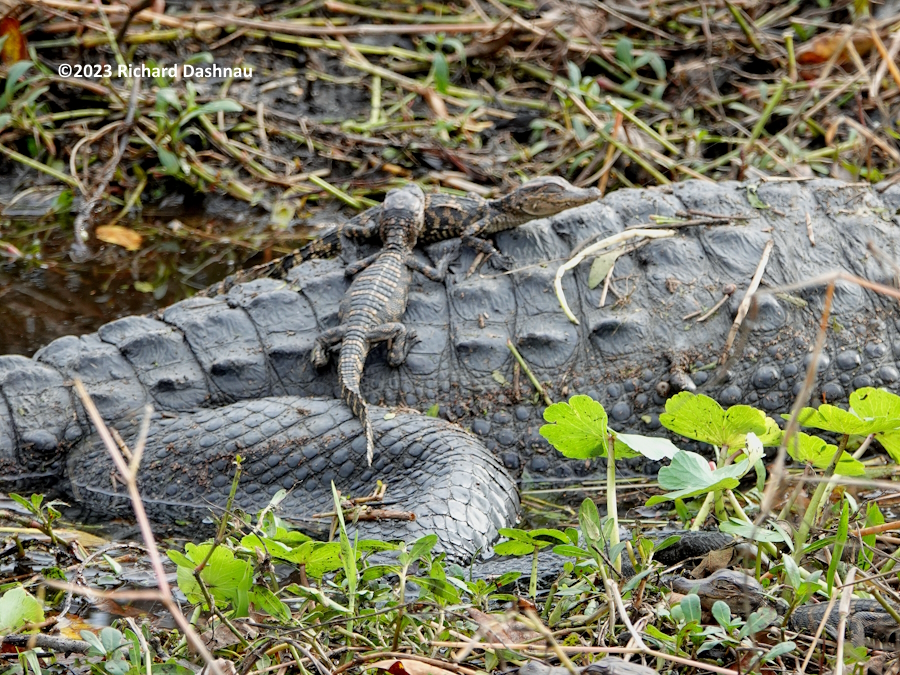
And,
this
page shows
alligators at the park, on land, near various landmarks at the park.
Go back to my
main alligator page, Alligators
Go
back to my home page, Welcome
to rickubis.com
Go
back to the RICKUBISCAM
page.






















































































































































































































































